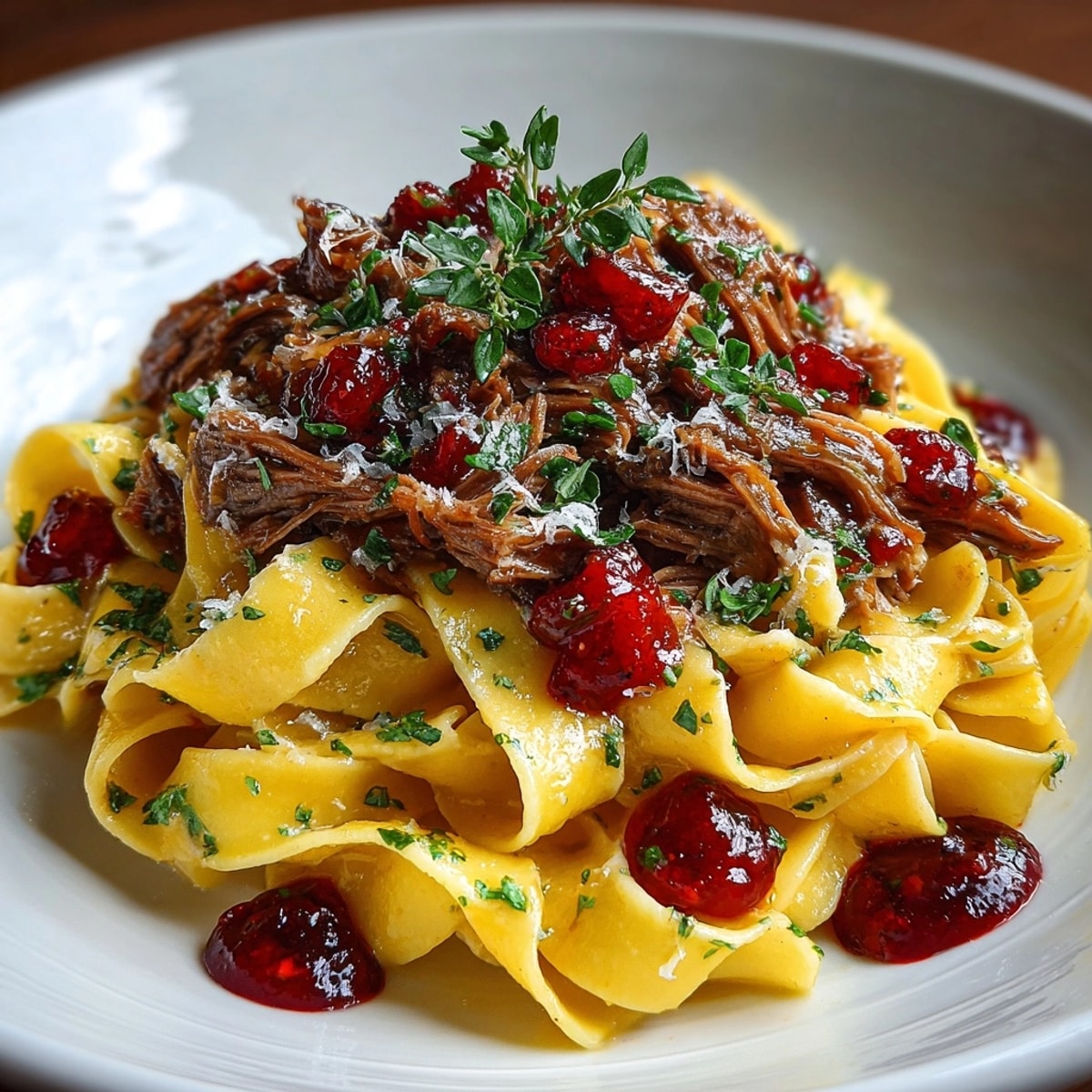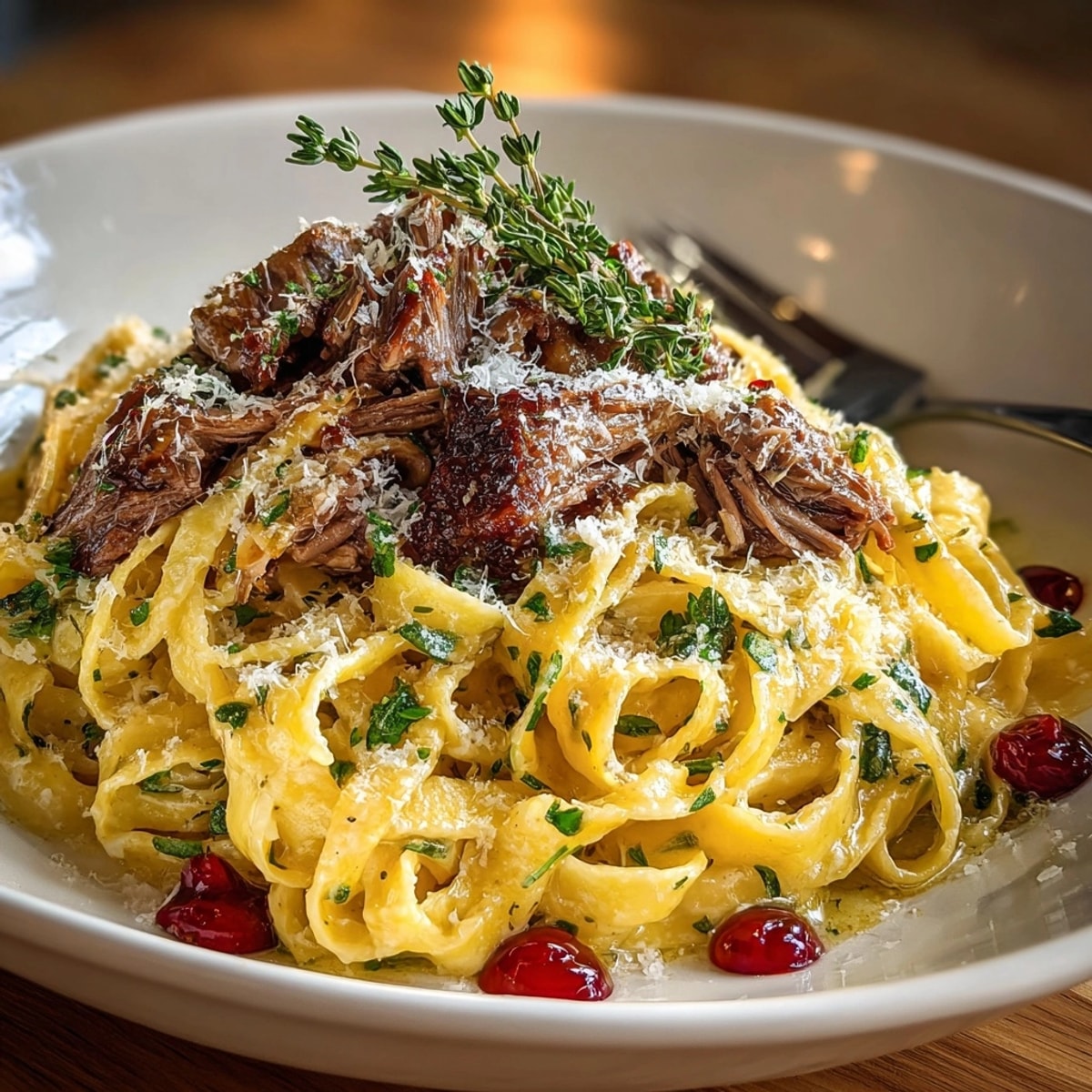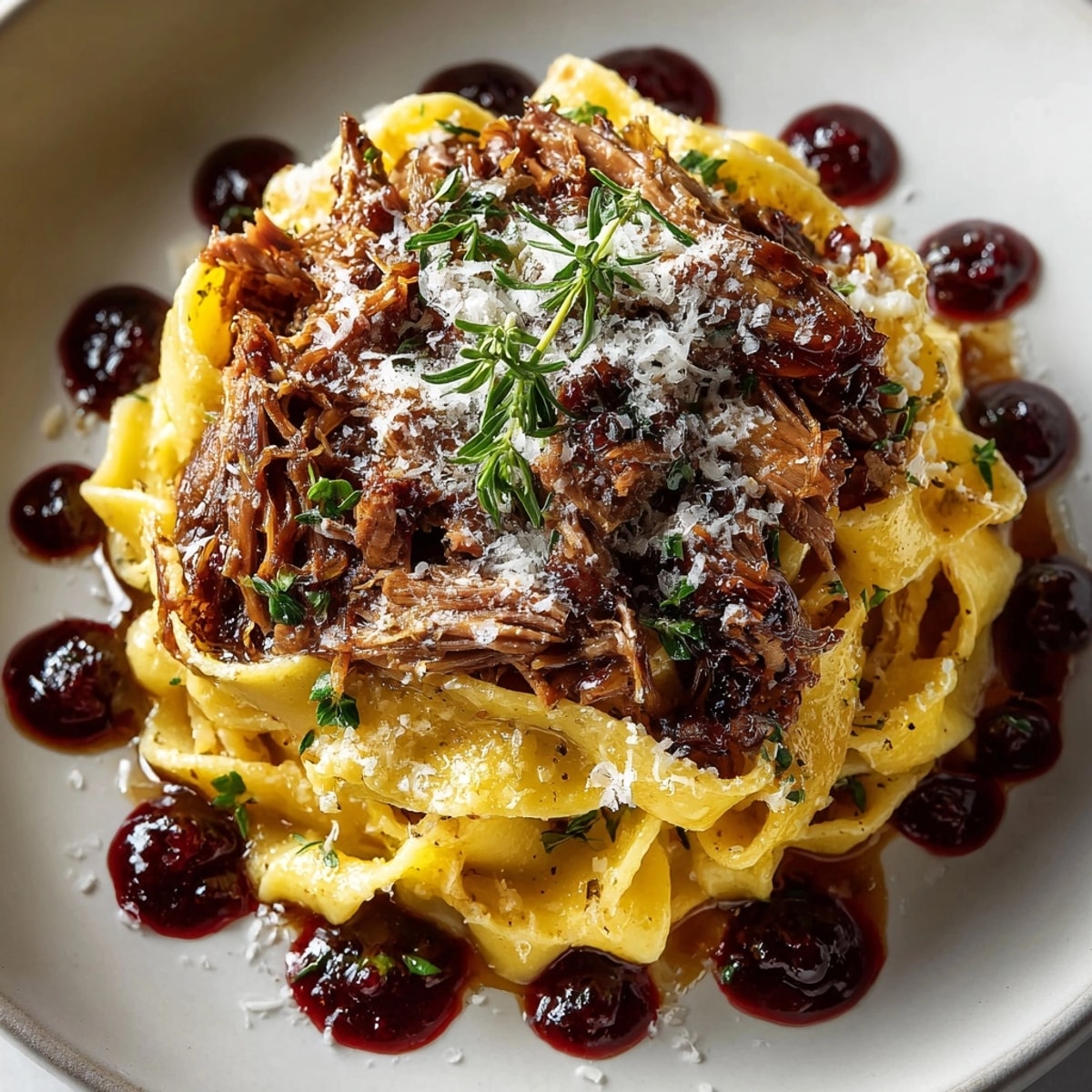 Save
Save This luxurious duck confit pasta transforms humble tagliatelle into a restaurant-worthy dish with minimal effort. The tender shredded duck meat creates a rich sauce while the cherry gastrique adds sophisticated sweet-tart notes that elevate the entire experience.
I first created this recipe when trying to impress my in-laws during their first visit to our home. The elegant presentation and complex flavors made them think I'd spent all day in the kitchen, when really I was relaxing with them until just before dinner.
Ingredients
- Duck confit legs: provide rich, tender meat without requiring slow cooking yourself look for them at specialty markets or online
- Tagliatelle pasta: offers the perfect texture and surface area to hold the sauce choose bronze-die extruded for best results
- Shallots: create a sweeter, more delicate base than onions select firm ones with no soft spots
- White wine: adds acidity and deglazes the pan use something you'd enjoy drinking
- Cherries: form the base of our gastrique frozen work perfectly when fresh aren't in season
- Red wine vinegar: provides essential acidity that balances the sugar in the gastrique
- Duck fat: renders from the confit and delivers incredible flavor save extra for roasting potatoes
Instructions
- Prepare the Cherry Gastrique:
- Combine cherries, vinegar, sugar, water, and salt in a small saucepan. Simmer over medium heat for 10-12 minutes, stirring occasionally until the cherries completely soften and release their juices. The mixture will gradually thicken to a syrupy consistency that coats the back of a spoon. Blend until completely smooth using either an immersion blender directly in the pot or transfer to a standard blender. Strain through a fine mesh sieve, pressing with a spatula to extract all the liquid. This removes any skin pieces and seeds for a perfectly smooth sauce.
- Prepare the Duck:
- Heat your oven to 180°C. Place the duck confit legs on a baking sheet and warm them for 10-12 minutes until thoroughly heated and the skin crisps up. The fat will begin to render, making the meat even more tender. Once heated through, either leave the crispy skin intact or remove it based on preference. Use two forks to shred the meat into bite-sized pieces, pulling against the grain for the best texture. The meat should separate easily from the bone.
- Cook the Pasta:
- Fill a large pot with water, adding about 1 tablespoon of salt per liter of water. Bring to a rolling boil before adding the tagliatelle. Cook according to package instructions until al dente, usually 7-9 minutes. Before draining, reserve about 100ml of starchy cooking water to help emulsify your sauce. Drain the pasta but do not rinse, as the starch helps the sauce adhere.
- Make the Sauce:
- Melt duck fat in a large skillet over medium heat until shimmering but not smoking. Add finely chopped shallots and cook for about 2 minutes until they become translucent but not browned. Add minced garlic and cook for just 1 minute more, stirring constantly to prevent burning. Pour in white wine and use a wooden spoon to scrape up any browned bits from the bottom of the pan. Let the wine reduce by half, which concentrates the flavor and cooks off the alcohol. Add stock and thyme, allowing the mixture to simmer for 3 minutes to meld flavors. Stir in the shredded duck meat and heat through for about 2 minutes. Lower the heat and swirl in butter pieces gradually until the sauce becomes glossy and slightly thickened. Season with salt and freshly ground black pepper to taste.
- Finish the Dish:
- Add the drained pasta directly to the skillet with the sauce. Pour in about half of the reserved pasta water and toss gently using tongs to coat every strand with the sauce. If the sauce seems too thick, add more pasta water a tablespoon at a time until you reach your desired consistency. Stir in the freshly chopped parsley just before serving to maintain its bright color and flavor.
- Plate and Garnish:
- Twirl portions of pasta onto warmed plates using tongs, creating a neat mound in the center. Distribute any remaining duck pieces from the pan evenly over each serving. Fill a squeeze bottle with the cherry gastrique for precise control, or use a small spoon to create artistic dots and drizzles around and over the pasta. The bright red gastrique creates beautiful contrast against the pasta. Finish with a light sprinkle of freshly grated Parmigiano-Reggiano and a few fresh thyme leaves if desired.
 Save
Save The cherry gastrique is truly the secret weapon in this recipe. I discovered the technique during a cooking class in France and have been applying it to everything from roast pork to vanilla ice cream. The balance of sweet and sour creates an addictive flavor that makes dishes taste professionally crafted.
Make-Ahead Options
This dish offers several components that can be prepared in advance, making it perfect for entertaining. The cherry gastrique keeps beautifully in the refrigerator for up to one week in an airtight container. Simply warm it gently before serving. You can also shred the duck meat up to two days ahead and store it covered in the refrigerator. When ready to serve, just prepare the pasta and sauce, then combine with your prepped components for a quick assembly.
Ingredient Substitutions
If duck confit is unavailable, substitute with slow-cooked chicken thighs simmered in olive oil with herbs until falling-apart tender. For a vegetarian version, replace the duck with roasted portobello mushrooms marinated in balsamic vinegar and thyme. The gastrique works wonderfully with other fruits too. Try blackberries in summer or cranberries during holiday season. For a gluten-free option, use rice pasta or chickpea pasta instead of wheat tagliatelle. The sauce is naturally gluten-free.
Serving Suggestions
This elegant pasta deserves thoughtful accompaniments. Serve with a simple green salad dressed with a light vinaigrette to cut through the richness of the duck. A crusty baguette makes an excellent vehicle for soaking up any remaining sauce. For wine pairing, choose a medium-bodied red like Pinot Noir or Beaujolais that won't overpower the delicate flavors. If you prefer white, a lightly oaked Chardonnay complements the richness beautifully.
The Art of Gastrique
A gastrique is a classic French sweet-and-sour sauce that adds incredible dimension to savory dishes. The technique dates back centuries and was originally used to balance rich game meats. The key is achieving the perfect balance between sugar and acid. The sugar is typically caramelized first, then deglazed with vinegar, creating complex flavors through the Maillard reaction. Our cherry version skips the caramelization step because the fruit provides natural sugars and complexity. Once you master this basic technique, experiment with different fruit and vinegar combinations.
 Save
Save Enjoy this sophisticated yet easy-to-make duck confit pasta for a truly memorable meal.
Recipe FAQ
- → How do I get tender, flavorful duck confit?
Warm confit duck legs in the oven until heated through with crispy skin, then shred. The slow confit process ensures meat stays juicy and rich.
- → Can I use other types of pasta?
Tagliatelle and pappardelle work best, but fettuccine or egg noodles are good alternatives. Choose wide shapes for better sauce coating.
- → Is the cherry gastrique sweet or tangy?
The gastrique is both; cherries and vinegar create a balance of fruity sweetness and lively acidity, heightening savory elements.
- → What wine pairs well with this dish?
Serve with Pinot Noir or another light-bodied red wine to complement the richness of duck and the brightness of the cherry gastrique.
- → Are there any substitutions for duck confit?
Roast chicken makes a lighter swap, and adding sautéed wild mushrooms gives earthy flavor and texture.
- → How do I achieve a glossy sauce?
Gently swirl cold butter into the reduced sauce off-heat for a smooth, shiny result before adding the pasta and duck.